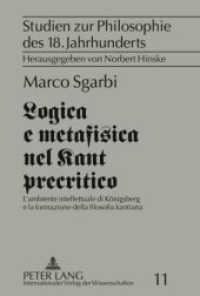- ホーム
- > 洋書
- > ドイツ書
- > Mathematics, Sciences & Technology
- > Mathematics
- > probability calculus, stochastics, mathematical statistics
Full Description
This book provides a reference for people working in the design, development, and manufacturing of medical devices. While there are no statistical methods specifically intended for medical devices, there are methods that are commonly applied to various problems in the design, manufacturing, and quality control of medical devices. The aim of this book is not to turn everyone working in the medical device industries into mathematical statisticians; rather, the goal is to provide some help in thinking statistically, and knowing where to go to answer some fundamental questions, such as justifying a method used to qualify/validate equipment, or what information is necessary to support the choice of sample sizes.
While, there are no statistical methods specifically designed for analysis of medical device data, there are some methods that seem to appear regularly in relation to medical devices. For example, the assessment of receiver operating characteristic curves is fundamental to development of diagnostic tests, and accelerated life testing is often critical for assessing the shelf life of medical device products. Another example is sensitivity/specificity computations are necessary for in-vitro diagnostics, and Taguchi methods can be very useful for designing devices. Even notions of equivalence and noninferiority have different interpretations in the medical device field compared to pharmacokinetics. It contains topics such as dynamic modeling, machine learning methods, equivalence testing, and experimental design, for example.
This book is for those with no statistical experience, as well as those with statistical knowledgeable—with the hope to provide some insight into what methods are likely to help provide rationale for choices relating to data gathering and analysis activities for medical devices.
Contents
1. Some Fundamentals - Probability.- 2. Some Fundamentals - Estimation and Inference.- 3. Confidence.- 4. Power and Hypothesis Testing.- 5. Least Squares: Regression and ANOVA.- 6. Product Design - Factorial Experiments.- 7. Process Control.- 8. Inspection and Acceptance Sampling.- 9. Shelf Life, Stability, Reliability, Time-to-Event.- 10. Diagnostics: Sensitivity and Specificity.- 11. Equivalence and Noninferiority.- 12. Nonparametrics.- 13. Bayesian Methods.- 14. Prediction, Classification, Non-Linear Modeling.- 15. Variance Components and Precision.- 16. Time Series and Dynamic Systems.- 17. Odds, Odds Ratios, and Comparing Proportions.- 18. Afterword.








